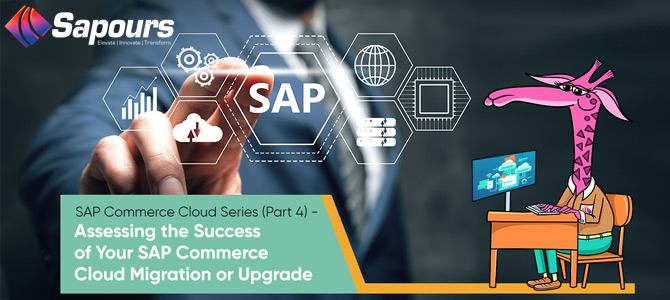The global eCommerce sales size is expected to reach over USD 5.54 trillion in 2022. The COVID-19 pandemic accelerated the adoption of eCommerce as a more convenient and safer choice of shopping for billions of consumers worldwide. For retailers, however, the shift to eCommerce required a holistic adoption of a large new enterprise technology stack comprising commerce, marketing, customer experience, payments, and much more. Though eCommerce has been around for decades, the level of democratization in the sector has reached a significantly high volume only in the past couple of years, especially since the pandemic struck in 2020.
As they continue to explore newer capabilities, brands often engage in migrating their eCommerce infrastructure from one platform to another for various reasons. Today, one of the most prolific names in the eCommerce enablement platform market is the SAP Commerce Cloud. Thousands of online retailers are transitioning from their age-old eCommerce infrastructure into a modern cloud-based high-performance digital ecosystem that SAP offers. While the benefits of SAP Commerce form the core matter of discussion for another blog topic, it is important to learn about completing your SAP commerce cloud migration successfully. How can enterprises measure if a migration exercise to SAP commerce cloud was successful? One of the oldest known methods that still hold much relevance in this context is to: Evaluate core KPIs.
For any eCommerce business, there are some core KPIs they need to track to evaluate the growth trajectory of the business. We have already covered them in our blog on “KPIs you Need to Validate for a Better eCommerce” but let’s just mention them here. The most important KPIs from an eCommerce business perspective are
- Conversion rates
- Average order value
- Cart abandonment rate
- Customer acquisition costs
- Time to purchase
- Website response rate
You can check out the blog to know in detail about these individual metrics and KPIs and get a clear picture of how to measure each one of them according to your unique business models.
However, as we are continuously seeing progress and innovation in the industry with respect to technology, there are more specific areas for which the right questions need to be framed and asked to the right stakeholders. The answers will form the basis on which the success of the SAP Commerce cloud migration will be measured.
Let us examine in detail the key areas or questions that need to be focused on to determine the level of success in such a large-scale eCommerce transformation exercise:
Have your major problems been solved after the upgrade or migration?
There may be several reasons that led to the selection of SAP Commerce Cloud as the preferred choice for a business’s eCommerce transformation. Once the implementation is complete and your entire business has moved into SAP Commerce Cloud, it is time to relook at the problem you faced earlier. You need to ask all stakeholders whether their core issues have been resolved with the new migration.
How much manual work is still being carried out in the business?
One of the main aims of any modern digital initiative is to eliminate manual intense processes and workflows. For eCommerce, the objective is no different. However, even after the migration, if the majority of the work is still done manually, it is an indication that your migration journey is flawed or not properly executed. It could either be due to poor planning or lack of knowledge about SAP Commerce Cloud capabilities by your vendor.
Do you experience better speed when compared to the past system?
In the digital economy, time is money. Customers want digital apps to load fast on their devices. They do not care if it is peak season traffic or even if they are on a poor internet connection. Capabilities like autoscaling will help retailers manage heavy spikes in online traffic for the holiday shopping season. But are they being leveraged in your implementation? For online retailers, this is one of the biggest fears as they do not want to lose out on an opportunity to convert visitors into shoppers. As covered in the other blog, cart abandonment is a serious problem, and the speed of the shopping website will certainly be a deciding factor that influences abandonment rates.
Can you offer all the latest features of SAP Commerce Cloud to your shoppers?
SAP understands the pulse of modern retail and invests heavily in R&D to build the most desirable retailing features in their offerings. For a retailer, one of the key questions they need to ask to measure their success with the SAP Commerce Cloud is “Are our customers able to enjoy all the latest features?” If the answer is no, then your migration activity requires a major review and re-engineering.
Getting accurate answers to these questions is critical in measuring the success of your SAP Commerce Cloud migration. It is always advisable to have a well-laid out strategic roadmap before beginning the migration exercise to avoid getting a negative sentiment in response to these questions. However, for such a strategic advancement, it is imperative that you engage an experienced SAP Commerce Cloud partner like Sapours to guide you in every step.
Talk to us to know more.

